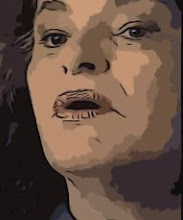"The serial killer has become an American Original, a romantic icon, like the cowboy."
- Joel Achenbach
Why does our culture romanticize the outlaw image? Increasingly driven by the weight of numbers, we are forced to give up our sense of control over our lives. Authoritarian repression combined with manifest corruption in high places is demoralizing. One way to seize back that sensation of personal power is to defy authority, to go out of bounds, to transgress.
The dizziness of deviance, the sensuality of sin is intoxicating in a double sense... first insofar as it gives you a euphoric, manic sensation, a rush... and secondly, in the sense that toxic thoughts affect your mind much as toxic substances affect your body.
Back when the first few cases of serial murder were beginning to surface, the symbolic "fuck-you" of the Elvis pelvis gave most wannabe free-spirits enough of a buzz to get them through the night. But succeeding waves of disaffected youth have pushed the envelope of rebellion further and further, until in their quest for the edge that really cuts, they arrive at the ultimate American iconoclast, the modern serial killer who personifies Carl Panzram's grim motto, "Rob 'em all, rape 'em all, and kill 'em all!"
The serial killer has become an icon because he has maxed out, gone over the top. We all imagine outrageous acts, but few actually do them. We are fascinated by those who have ventured further into the forbidden zone than our timid souls dare.
But the mystique of lawlessness is scarcely new. Isn't the modern serial killer cast in the same role as dark folk heroes like Wyatt Earp and Jesse James? Or Robin Hood, or Lancelot? What about King David? Killed his own top military chief because he lusted for his wife Bathsheba, and went on to make mass slaughter his claim to fame. And the legendary Viking chieftain Eric the Red wasn't called Red for his hair color.
Untrammeled spirits with fearsome names like Dionysus, Kali, and Shango once roamed the earth with fierce bloody ardor, inspiring much the same quasi-erotic, trembling fascination as Ted Bundy and the Night Stalker. You could almost say that if serial killers didn't exist, we would be sure to invent them.
Along the edge of this multi-celled creature that comprises our human existence reside our most sensitive cells. These are the highly-reactive sensors of our collective nervous system -- the flaky ones, the shaky ones, psychics and artists, writers and musicians, geniuses and the certified insane. All shamans unaware. Their function is to monitor the edge and report what's beyond it, so that those who live in bubbles don't have to take those risks. "There be monsters!" they scream, rolling their eyes, and that's all we need to know.
The romanticization of the high-profile criminal is a function of the aesthetic of ugliness. There's an social and spiritual auto-immune reaction going on throughout the world right now, with a lot of ugliness around the edge. Most of our artistic voices are spewing forth a limitless barrage of anger, fear, disgust and outrage at what they see coming as the fabric of our existence shreds in this apocalyptic age: "I've seen the future, and it is murder."
This is not to suggest that the murderer is an artist, but the violent criminal has a message for us the same as the artist does. In their own grim pre-conscious way, these sensitive souls are expressing a reaction to the same deep seismic temblors.
But how to read these cryptic messages inscribed in blood? The killer may see no cosmic significance to his acts. He may believe he is merely acting out his own personal agenda. But the very fact that these dramas exist makes it our business to interpret them. We turn our eyes away from the monstrous bloody truths scrawled on our floor. But they don't go away. In the darkness of our will to ignorance, they gain more power.
Outrageous crimes evoke our most primal fears of mortal vulnerability, and at the same time, unleash own darkest secret passions. Our revulsion is so mixed with fascination that even if we cover our eyes, we are compelled to keep watching through the cracks.
Our brain houses a magic theater where little holographic models enact what we perceive as reality. Once we comprehend what a killer is, we bring him to life within our own mind. Thanks to media dedicated to conveying the vivid imagery we demand to our enthralled minds, we all have at least one little phantasmagorical Manson dancing around in a dark corner, casting his helter-skelter spells.
If the Manson in our mind somehow loosens the bonds of fantasy, breaks out of the Theater of the Mind, and springs full-fledged to life in the Theater of the Real... somebody's bound to get hurt.
But of course, we wouldn't want that to happen. Our audience never wants to actually get hurt; they just want to watch... while someone else gets hurt.
This, then, is what comes out only after the giddy Murder for Fun crowd has left the theater and the house lights are dimmed. We are going directly into that doomed domain where all the fallen angels chant their haunted songs.
"It is lurid and melodramatic, but it is true."
- D.H. Lawrence
Friday, January 16, 2009
Subscribe to:
Post Comments (Atom)

No comments:
Post a Comment